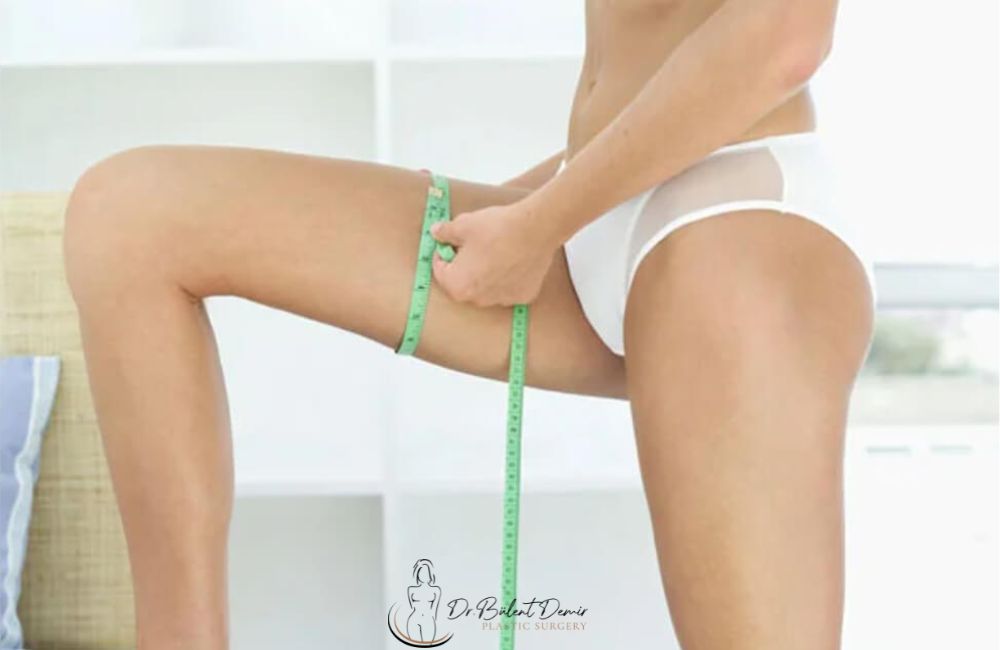Thigh Lift
Femoral Stretching Surgery is also known as Upper Leg Stretching . It is applied to fix saggy and loose parts of the upper part of the legs, caused by reasons such as ageing, childbirth, weight gain and loss. During the surgery, saggy tissues are removed and, if there is a complaint of lipidosis, then laser liposuction is applied. Fat stored in the femoral area is burnt and then the legs have a better appearance. This surgery, which is performed with general anaesthesia, takes several hours.
The upper leg area is called the ’femur’. Surgery to remove sagging and loosening of the skin on the inside of the Femur is called a femoral stretching operation. In this surgery, unnecessary (excess) skin and fatty tissue on the upper and inner sides of the femur are removed.
Get rid of excess fat in your body with thigh lift-leg stretching in Antalya , increase your self-confidence and get a younger and refreshed appearance with the guarantee of fast recovery and perfect results.
Types Of Femoral Stretching Surgeries
- Upper Leg Stretching: Targets the part, where the inguinal region and femur meet. The incision process is performed, where the femur meets the inguinal region. During this process, an excess amount of skin is removed. Spores and resistant fatty tissue are removed with the help of liposuction.
- Inner Leg Stretching: It is performed to remove an excess amount of fat and skin located on the inner side of the femur. The mark (after the surgery) remains on the inside of the leg. Liposuction can also be performed in the same session. Combining it with a method such as Vaser Liposuction plays a major role in maintaining vascular structures and increasing the success rate.
- Mini Leg Stretching: This surgery is a sub-form of internal leg stretching surgeries. The only difference is that it requires a smaller incision area. This procedure, performed at the junction of the leg with the inguinal region, has limited effectiveness. But it does not leave any obvious scars; and, the recovery time is faster than the other surgery.
How Is Femoral Stretching Surgery Performed?
First of all, it is necessary to determine the grade of saggy tissues. The amount of fat stored inside the legs is also measured and the patient is informed about the incision area. In these surgeries, an incision area is opened from the inguinal region to the inner part of the femur. Excess skin and fatty tissue are removed through this incision. The skin on the bottom is stretched and then pulled upwards. Then the surgery is completed after this part of the skin is stitched to the inguinal region. The scar that shall appear after the surgery shall remain in the area between the femur and inguinal region; thus, it shall not be noticeable from the outside. For monitoring and precautionary purposes, the Patient stays in the hospital for a day after surgery. After 1 Week, the patient in question can return to his/her daily life. But the Patient is advised to stay away from physical exercises for up to 4 weeks.
Femoral Stretching Plastic Surgery can be performed using the transverse incision method; however, this technique may not give the targeted result in those, who experience weight loss. In such a case, it shall be necessary to stretch the skin inside the femoral area longitudinally. For this reason, T-Shaped Incision should be preferred for Patients in this group.
What Should Be Considered After Femoral Stretching Surgeries?
- The surgery does not cause severe pain. However, after surgery, the Patient must rest plenty.
- Corsets and Urine Probes are routinely used. The Incision Area is quite close distance to the Urinary Line. A possible contact may lead to later healing of the scar. After surgery, the patient should be closely monitored.
- It is important to care for and dress the Patient’s scars so that the Patient’s stitches do not deform and open.
- Prescribed medications should be used regularly.
- After surgery, smoking should be stopped for a while. Alcohol consumption should also be avoided. These factors delay the recovery of the patient.
- Long Distance Walks should be avoided.
- It is necessary to wait at least 6-8 weeks to start sports; the patient must necessarily get the approval of the plastic surgeon on this issue.
- Care should be taken to ensure that the patient sleeps enough every day so that the body can recover more quickly.
- Stretching the leg area and excessive exercises should be avoided. For a while, you should avoid exhaustive activities; exercises such as squatting and climbing stairs should also not be preferred.
- Since you are going to have to wait an average of up to a month before you can return to your normal exercise routine, it is recommended that you should follow a proper diet program until then. In this way, caloric intake and expenditure shall be balanced.
- Salt consumption should also be restricted. Because the excess amount of salt causes oedema in the body.

